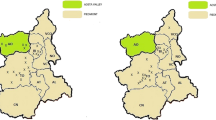Abstract
As was shown (1), analysis of human hair on the population level and mapping of large territories using hair elemental composition are promising approaches for estimation of both the environmental situation and the population health status. In (1,2) the map of Uzbekistan (sampling in 1981) was discussed. Ten years later (1991), samples from the territory in the vicinity of the drying out Aral Sea were taken again. Samples were analyzed for 24 elements using instrumental neutron activation analysis. Comparison of the data and maps drawn for 1981 and 1991 and their comparison with changes of the health status have shown that repeated mapping of territories using data on human hair elemental composition could be used in medical geography, especially for prediction of health status changes in ecologically unfavorable areas.
Similar content being viewed by others
References
L.I. Zhuk and A.A.Kist, Global Ecology and the Human Hair Composition,Radioanal. Nuclear Chem. 174(1), 73 (1993).
L. I. Zhuk and A. A. Kist, Mapping Technique Based on Elemental Hair Composi-tion Data,Nuclear Analytical Methods in the Life Sciences, Humana Press, Clifton, NJ, 307–320 (1990).
A. A. Kist, R. I. Radyuk, L. I. Zhuk, V. P. Pikul, and A. D. Belyaev, Human Hair Radioactivity in the Chernobyl area,J. Alloys Compounds 213/214, 81–85 (1994).
L. I. Elpiner and V. M. Delitsyn, Medico-biological aspects of Aral catastrophe,Izv. AN SSSR, Ser. Geograf. Nauk (In Russian) 4, 103–112 (1991).
Yu. S. Ryabukhin, Activation analysis of hair as an indicator of contamination of a man by environmental trace elements pollutants,J. Radioanal. Chem. 60(1), 7–31 (1980).
M. Baku and R. M. Parr, Interlaboratory study of trace and other elements in the IAEA powdered human hair reference material, HH-1,J. Radioanal. Chem. 69, 171–180 (1982).
A. A. Kist and L. I. Zhuk, Human hair composition and the problems of global ecol-ogy, INP Preprint R-3-509, Tashkent, 66 (1991).
A. A. Kist, Elemental abundances in nature—Fortuity or conformity to natural laws?J. Radioanal. Nuclear Chem. 192(2), 255–263 (1995).
L. I. Zhuk and A. A. Kist, Human hair instrumental neutron activation analysis and medicine,J. Radioanal. Nuclear Chem. 195(1), 75–81 (1995).
Health Related Monitoring of Trace Elements Pollutants Using Nuclear Techniques, Vienna, IAEA, TECDOC-330 (1985).
J. G. Bacso, G. Lusztig, A. Pal, and I. Uzonyi, Comparative investigation of some min-eral elements in the aortic wall and the calcium concentration in hair,Exp. Pathol. 29, 119–125 (1986).
S. Sarmani, T. Koshy, and Z. Zakaria, Scalp hair as an indicator of environmental pol-lution in Malaysia,Health-Related Monitoring of Trace Elements Pollutants Using Nuclear Techniques, Vienna, IAEA, TECDOC-330, 205–209 (1985).
S. Sarmani, A study of trace element concentrations in human hair of some local pop-ulation in Malaysia,J. Radioanal. Nuclear Chem. 110(2), 627 (1987).
J. Arunachalam, S. Gangadharan, and S. Yegnasubramanian, Elemental data on human hair sampled from Indian student population and their interpretation for studies in environmental exposure,Nuclear Activation Techniques in the Life Sciences, Vienna, IAEA-SM-227/24, 499–515 (1978).
S. Gangadharan, J. Arunachalam, K. R. Bhat, and S. Yegnasubramanian, Trace metal pollutants in Filipino human head hair,Health-Related Monitoring of Trace Element Pol-lutants Using Nuclear Techniques, Vienna, IAEA, TECDOC-330, 147–154 (1985).
T. Takeushi, T. Hayashi, J. Takada, and M. Koyama, Survey of trace elements in hair of normal Japanese,Nuclear Activation Techniques in the Life Sciences, Vienna, IAEA-SM-227/17, 545–561 (1978).
H. Tomoko, Metals in normal human skin and hair,Hiroshi Med. J.,4(26), 363 (1982).
A. A. Kist,Phenomenology of Biogeochemistry and Bioinorganic Chemistry (In Russian), Tashkent, FAN, p. 236 (1987).
Author information
Authors and Affiliations
Rights and permissions
About this article
Cite this article
Kist, A.A., Zhuk, L.I., Danilova, E.A. et al. Mapping of ecologically unfavorable territories based on human hair composition. Biol Trace Elem Res 64, 1–12 (1998). https://doi.org/10.1007/BF02783320
Received:
Accepted:
Issue Date:
DOI: https://doi.org/10.1007/BF02783320




